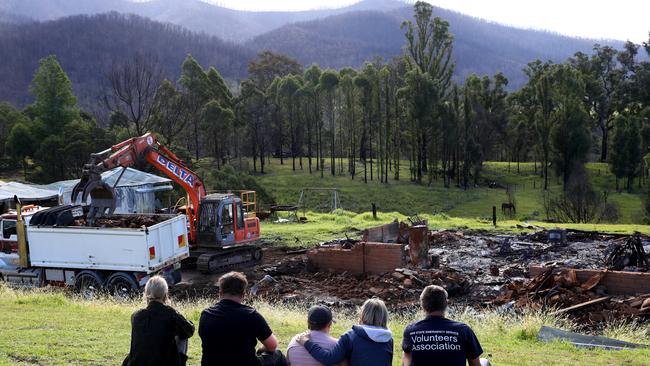We need an inquiry into climate alarmism
I hope you’re sitting down; this foray into climate madness starts with recognising some excellent journalism by the ABC.

McDonald used this to give us the brilliantly counterintuitive opening line; “It began not with fire, but ice.” In a series of reports, McDonald and her team retraced the history of the fire over a number of weeks, how it was almost extinguished by rain, how bushwalkers in the wrong place at the wrong time thwarted a backburn that might have stopped it, how another prescribed burn got out of control and destroyed houses, and how a fortuitous wind change stopped it encroaching on suburban Sydney.
We might quibble with some of the alarmist language — repeating the silly new “megafire” term and pretending that when fires meet they join and get bigger when, in fact, this reduces the number of fronts and total length of fire perimeter — but overall the reporting was factual and admirable because it explained the many variables in fire behaviour and the factors that can influence whether a fire can be contained or extinguished before weather conditions turn it into an unstoppable beast. Surprisingly, and refreshingly, the reports did not dwell on climate change.
When it comes to our bushfires climate change is so close to being irrelevant, it should hardly warrant a passing reference — we have always faced disastrous bushfire conditions and always will. If climate change makes the worst conditions either marginally more or less common, it matters not; we still need to do the same things to protect ourselves.
In previous articles I have detailed the leading scientific analysis showing the main precondition for the NSW fires — a long drought — cannot be attributed to climate change. Unless climate activists want to argue Australia could do something to alter the global climate sufficiently to reduce our bushfire threat, they are exposed as cynical campaigners who used the sure bet of bushfires to advance their political scare campaign.
The NSW bushfire inquiry released this week took a dive into the climate science — as it was tasked to do — and found, predictably enough, that climate change “clearly played a role in the conditions” that led up to the fires and helped spread them. But thankfully it did not waste much time on climate in its recommendations, merely suggesting climate trends need to be monitored and factored in.
Apart from exercises in politically correct box ticking — Indigenous training for evacuation centre staff so they are “culturally competent”, wildlife rescue training for firefighters, and signs to promote ABC radio stations — most of the recommendations were practical. Better equipment for firefighters, more water bombers, more communication, public education and most importantly, a range of suggestions on fuel reduction around settled areas and planning controls on building in fire prone areas.
The bottom line has always been obvious: the one fire input we can control is fuel, so where we want to slow blazes or protect properties, we must reduce fuel. Planning is also important to prevent housing in indefensible locations, but one crucial phrase missing from the report was “personal responsibility”.
Houses on wooded hilltops or surrounded by bush cannot be protected and their residents should not expect others to risk their lives trying to do so.
People must be educated to clear extensively around properties, sufficient to withstand not a moderate fire but a firestorm, otherwise they must be prepared to surrender their homes and escape early.
“Hazard reduction is not the complete answer,” said report author Mary O’Kane. “People do need to take responsibility, they need to realise that if they live in certain areas it can be very dangerous, and we try to give a strong message of, if you are in a dangerous area and there is one of these big, bad megafires, the message, is get out.”
O’Kane is right, of course. But it seems a hell of a waste to hold a full inquiry only to be told we should do more fuel reduction, be careful where we build houses, and get the hell out of the way rather than try to fight firestorms. We knew all this.
The push for an inquiry was largely driven by the climate catastrophists. Remember, they wanted to blame the blazes on the axing of the carbon tax, and on Scott Morrison. It was inane and rancid stuff.
They will be at it again, this fire season. They love making political capital out of disasters, although they go as quiet as Tim Flannery when it comes to full dams and widespread snowfalls.
The area of land burned in the Australian summer has now been revised down by 25 per cent, and the claims about wildlife deaths revised downwards too, to factor in the mind-blowing realisation that animals actually escape fire when they can — birds fly, wombats burrow, kangaroos hop and even koalas can climb to the treetops and escape all but a crowning blaze.
Remember we had articles in The Guardian, The New York Times, and on CNN and the BBC, saying the bush might never recover. Take a drive through the Blue Mountains, Kangaroo Island or the Australian Alps and see how their predictions turned out.
The sclerophyll forests of southern Australia are not just adapted to fire, they are reliant on it. Therefore, the wildlife also is reliant on it for the rejuvenation of the vegetation — why does basic ecology escape the climate activists? If it is any comfort, the same madness is now playing out in California. Similar climate, similar history of bushfires, and the same maddening political debate. With fires burning more than a million acres in northern California this month, the state’s Democratic Governor, Gavin Newsom, sent a recorded message to his party’s national convention; “If you are in denial about climate change, come to California.” The trouble is that while these are bad wildfires, they are not unusual in the natural and settled history of that environment.
Like the Australian bush, the redwood forests that US journalists suggest are being destroyed by fire, depend on fire for propagation. Just like here, one of the issues has been the suppression of bushfire by human interference, leading to the unnatural build up of fuel that can explode when a wildfire does get away in bad conditions.
Environmentalist and author of Apocalypse Never; Why Environmental Alarmism Hurts Us All, Michael Shellenberger says the climate is warming but the impact of this on fires is overstated. In an article for Forbes.com he quoted Scott Stevens of the University of California, Berkeley, saying climate change is not a major factor, as well as other experts scoffing of the idea that severe fires are anything new.
“California’s fires should indeed serve as a warning to the public, but not that climate change is causing the apocalypse,” wrote Shellenberger. “Rather, it should serve as a warning that mainstream news reporters and California’s politicians cannot be trusted to tell the truth about climate change and fires.”
Ditto for Oz. I have detailed previously how Fran Kelly told ABC audiences in November that “the fire warning had been increased to catastrophic for the first time ever in this country” — but that was wrong, wildly wrong.
Greens Senator Jordon Steele-John accused his political opponents of being “no better than arsonists” and other Greens and Labor MPs said Australia’s climate policies were exacerbating bushfires. Insane as this might be, it was amplified rather than interrogated by most media.
The thick smoke haze in Sydney was portrayed as something “unprecedented” — if it has not been on Twitter before it must never have happened — but a quick search of newspaper files found similar bushfire-induced shrouds in 1951, when airports were closed, and 1936, when a ship couldn’t find the heads.
Fires in rainforest areas of southern Queensland and northern NSW were not “unprecedented” either, with archived reports noting similar fires in the spring of 1951 and even the winter of 1946.
Despite 200,000 media mentions of “unprecedented” tracked by media monitors across December and January, the facts showed none of this was new. Greater areas were burned in 1851 and 1974-75, and human devastation was either as bad or worse on Black Saturday in 2009, Ash Wednesday in 1983, Black Tuesday in 1967, Black Friday in 1939 and Black Thursday 1851.
Bushland was not destroyed forever, koalas were not rendered extinct and Scott Morrison was not to blame. We should have an inquiry into climate alarmism, political posturing and media reporting — we would learn a lot more from that than we have from relearning age-old fire preparedness from yet another bushfire inquiry.




I hope you are sitting down; this foray into political and media madness over bushfires and climate change starts with recognising some excellent, forensic journalism by the ABC. Investigating last summer’s devastating Gospers Mountain fire, journalist Philippa McDonald took us to the very tree where the fire is believed to have been started when it was struck by lightning in a thunderstorm.